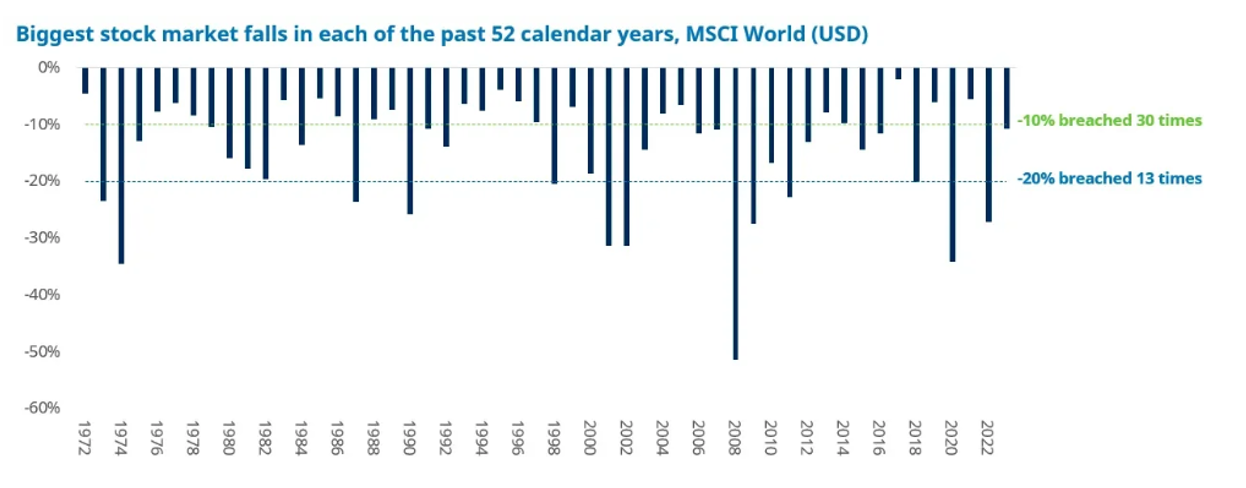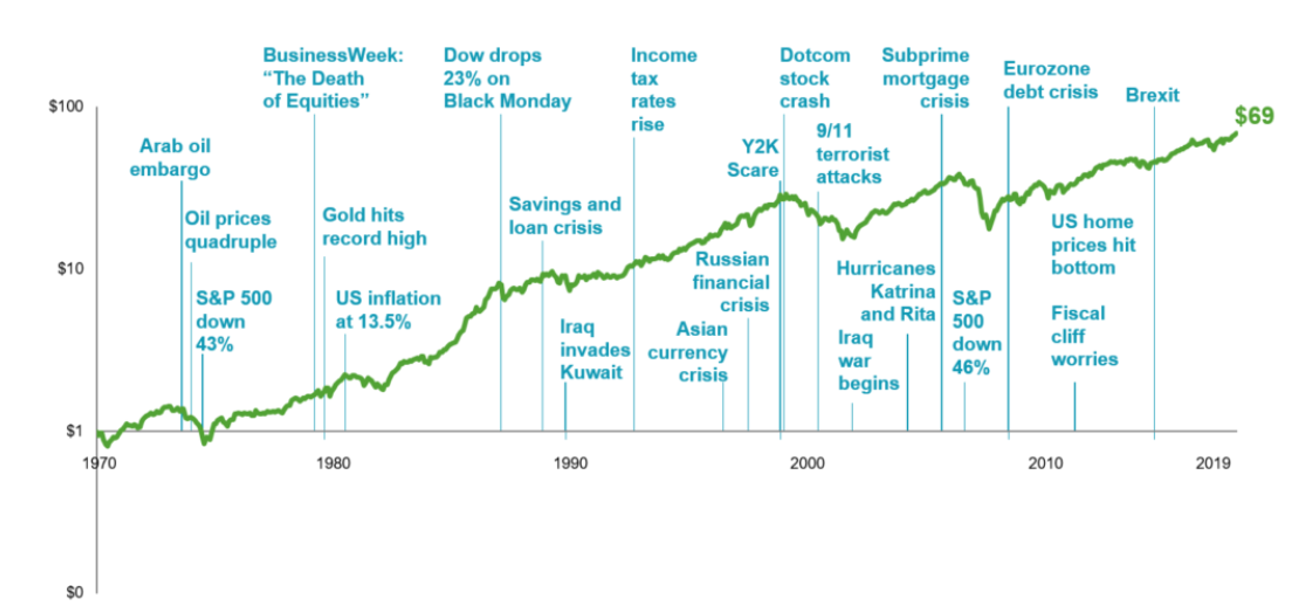Recent headlines regarding market volatility may have understandably left you feeling somewhat nervous about investing.
On 2 April, Donald Trump announced a series of trade tariffs under a banner that he called “Liberation Day”. Global markets dipped as investor confidence fell, only to rise sharply after Trump announced a 90-day hiatus for most of the tariffs.
Recent market volatility has been considerable in the wake of the tariffs, but short-term fluctuations driven by global events and shifts in investor sentiment are a normal part of investing.
While market downturns are inevitable, history shows that staying invested is often the most effective way to recover any short-term losses. Additionally, a well-balanced portfolio can help limit the effects of market dips on your wealth.
Read on to find out how you can protect your portfolio in volatile markets.
Double-digit drops are a common occurrence in markets
When markets fall, you may be tempted to move to cash to avoid further losses.
However, an important step in avoiding such knee-jerk reactions is to understand that dips are surprisingly common, and despite volatility, markets have historically delivered strong long-term growth.
Indeed, double-digit declines in global stock markets occur more often than not in any given year.
The graph below shows the biggest stock market falls between 1971 and 2023 on the MSCI World Index.

Source: Schroders
As you can see, falls of 10% or more happened in 30 of the 52 years, while more substantial falls of 20% or more occurred in 13.
To put that into the context of the recent volatility, Trustnet reports that the MSCI World Index dipped by 16.3% (in sterling terms) between its previous peak on 23 January and 22 April.
Despite the frequency of such dips, the MSCI World Index and other indices continue to trend toward growth in the long term.
Indeed, the graph below shows how much $1 would have grown on the MSCI World Index between 1970 and 2019 alongside significant events that have caused market downturns.

Source: Harvest
As you can see, dips caused by significant events are a regular part of investing, but the long-term trend remains upward. This highlights the importance of staying focused on the bigger picture rather than reacting to short-term volatility.
Historically, exiting during a market downturn has led to a longer recovery
It’s important to remember that a decline in portfolio value only becomes a real loss when you sell, and remaining invested has often been the quicker route to recovery than exiting for cash.
For example, research from Schroders shows that an investor who switched to cash after the first 25% drop during the Great Depression in 1929 wouldn’t have broken even until 1963. However, someone who remained invested would have recovered by early 1945.
A similar pattern played out during the 2008 financial crisis, as those who moved to cash after a 25% drop would still be recovering today, while those who stayed the course saw their investments rebound by 2013.
Although past performance can never reliably predict future performance, historically, staying invested has given your portfolio the best opportunity to recover if you experience losses during a downturn.
Portfolio diversification can help protect against volatility
Alongside focusing on long-term growth rather than short-term trends, a well-diversified portfolio can help limit your losses amid volatility and could even open you up to potential gains from wider markets.
Portfolio diversification helps ensure you aren’t overly concentrated in one region, industry, or asset class, which can enable a steadier and more stable path to growth.
For instance, the table below shows the annual ranked performance of different global indices between 2014 and 2024, as well as their performance in the year-to-date and last month.

Source: JP Morgan
As you can see, predicting which index will perform well from one year to the next based on previous performance is all but impossible. For example, the MSCI Asia ex-Japan was the strongest performer in 2020 and the weakest in 2021.
If your portfolio had been heavily concentrated in that index during those years, you would likely have faced significant volatility. In contrast, diversifying across multiple global indices could have reduced that volatility and provided more stable returns.
In April, Asian indices and emerging markets delivered positive returns, while European and US markets experienced losses. However, the two European indices remain among the top three performers in the year-to-date, which shows how short-term dips don’t always reflect broader trends.
The varying performance of different indices highlights the value of spreading your investments across multiple regions, as this can help reduce reliance on any single market and support steadier long-term growth.
A financial planner can help you protect your portfolio from volatility
In times of market volatility, staying focused on the bigger picture can be challenging, but a financial planner can help.
By building a plan around your long-term goals and recognising that market dips are a natural part of the journey, a financial planner can help you stay on course. They can also help you diversify your portfolio to limit your losses and open you up to wider opportunities.
To speak to a financial planner, get in touch.
Email contact@ambient-wm.com or call us on +34 658 077 450.
Please note
This article is for general information only and does not constitute advice. The information is aimed at retail clients only.
All information is correct at the time of writing and is subject to change in the future.
The value of your investments (and any income from them) can go down as well as up and you may not get back the full amount you invested. Past performance is not a reliable indicator of future performance.
